Abstract
Murine epidermal growth factor, a 53-amino acid peptide that is mitogenic for a number of cell types, has been synthesized by the solid-phase method. The synthetic peptide is identical to the natural material in amino acid composition, chromatographic behavior, receptor binding, and stimulation of DNA synthesis. Fragments of the EGF molecule corresponding to residues 42-53, 32-53, and 15-53 were constructed as well as the methionine sulfoxide derivative of EGF, [Met(O)21]EGF-(1-53), and a polymeric form of EGF. [Met(O)21]EGF-(1-53) was slightly less active than EGF in receptor binding and stimulation of DNA synthesis. Polymeric EGF was 1/100th as active as EGF, while EGF-(15-53) was less potent than EGF-(1-53) by a factor of 10(4). EGF-(32-53) was even less active and EGF-(43-53) was inactive.
Full text
PDF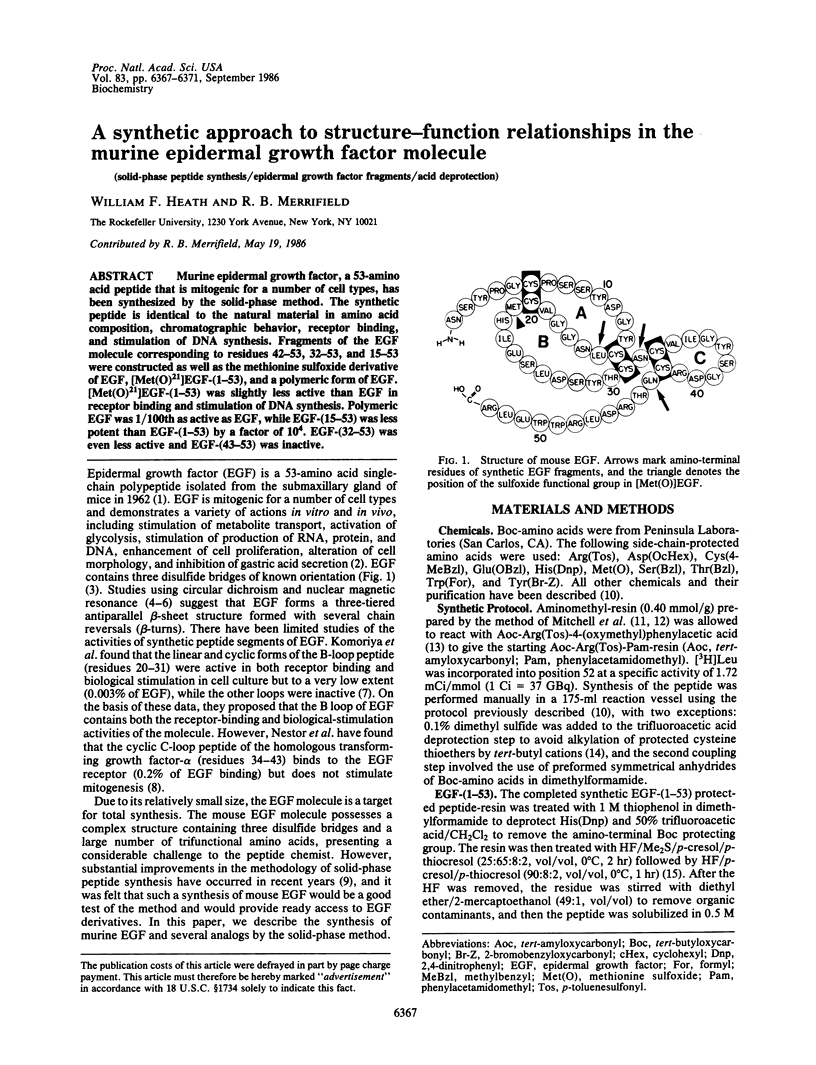
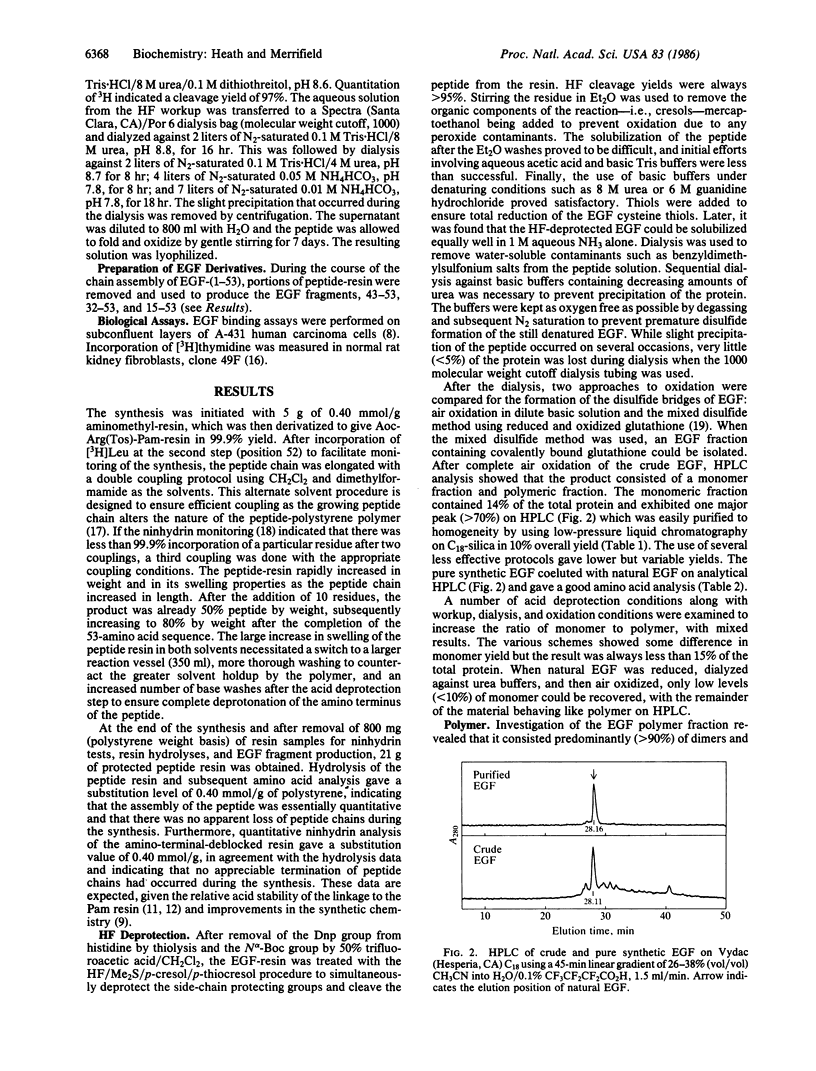
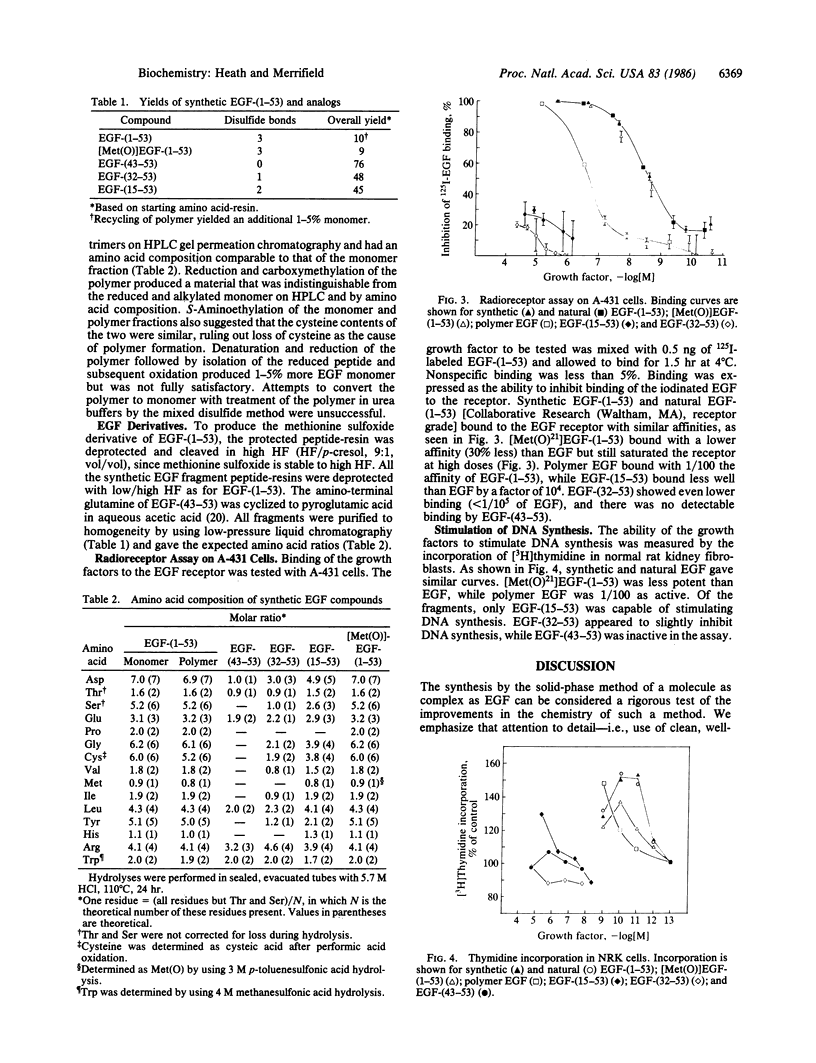
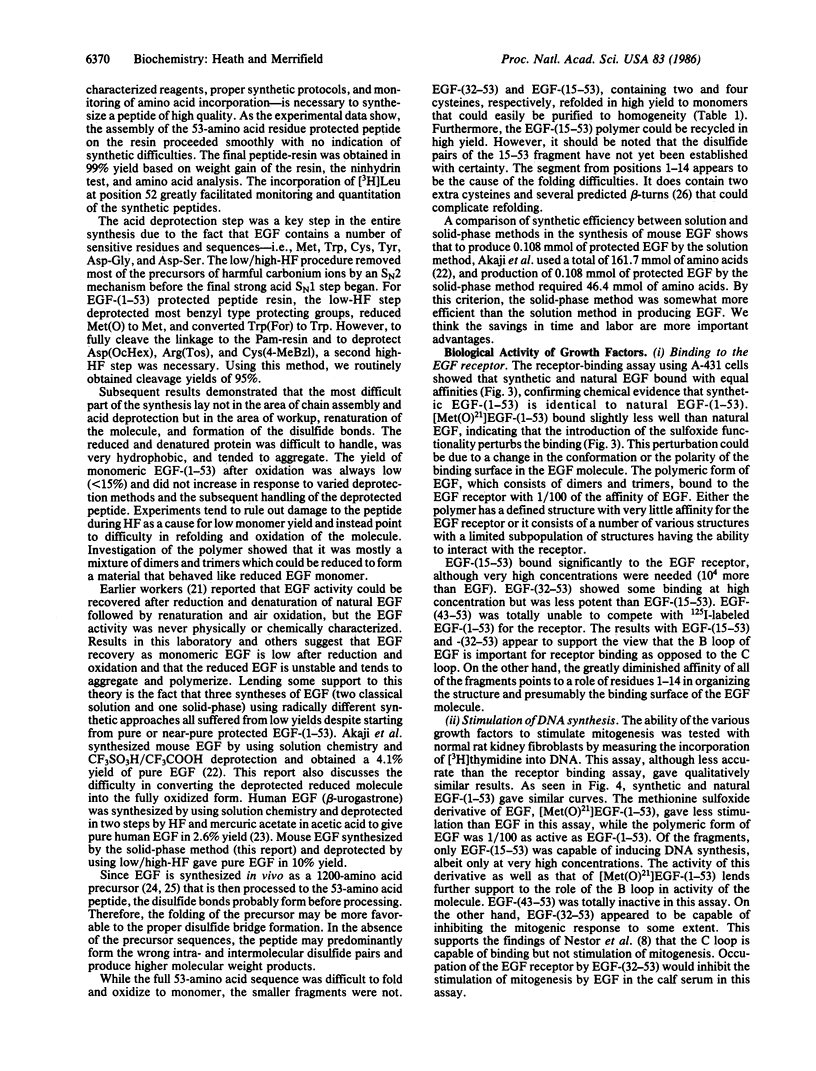
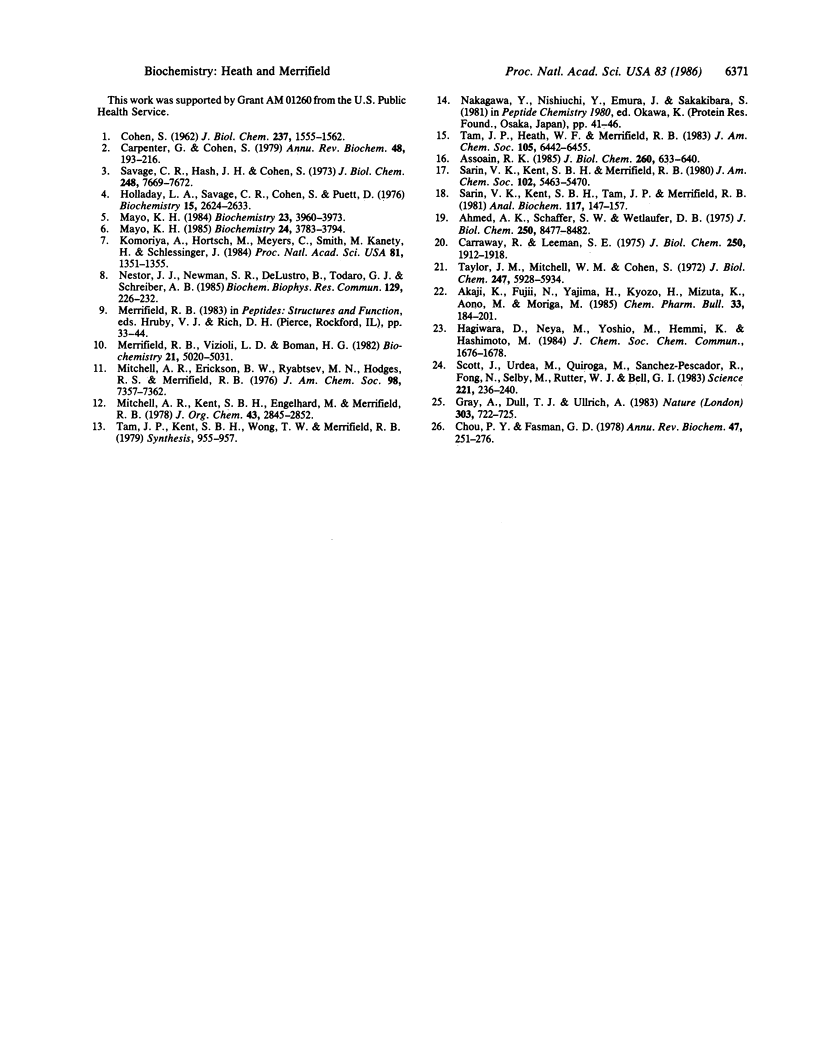
Selected References
These references are in PubMed. This may not be the complete list of references from this article.
- Ahmed A. K., Schaffer S. W., Wetlaufer D. B. Nonenzymic reactivation of reduced bovine pancreatic ribonuclease by air oxidation and by glutathione oxidoreduction buffers. J Biol Chem. 1975 Nov 10;250(21):8477–8482. [PubMed] [Google Scholar]
- Akaji K., Fujii N., Yajima H., Hayashi K., Mizuta K., Aono M., Moriga M. Studies on peptides. CXXVII. Synthesis of a tripentacontapeptide with epidermal growth factor activity. Chem Pharm Bull (Tokyo) 1985 Jan;33(1):184–201. doi: 10.1248/cpb.33.184. [DOI] [PubMed] [Google Scholar]
- COHEN S. Isolation of a mouse submaxillary gland protein accelerating incisor eruption and eyelid opening in the new-born animal. J Biol Chem. 1962 May;237:1555–1562. [PubMed] [Google Scholar]
- Carpenter G., Cohen S. Epidermal growth factor. Annu Rev Biochem. 1979;48:193–216. doi: 10.1146/annurev.bi.48.070179.001205. [DOI] [PubMed] [Google Scholar]
- Carraway R., Leeman S. E. The synthesis of neurotensin. J Biol Chem. 1975 Mar 10;250(5):1912–1918. [PubMed] [Google Scholar]
- Chou P. Y., Fasman G. D. Empirical predictions of protein conformation. Annu Rev Biochem. 1978;47:251–276. doi: 10.1146/annurev.bi.47.070178.001343. [DOI] [PubMed] [Google Scholar]
- Gray A., Dull T. J., Ullrich A. Nucleotide sequence of epidermal growth factor cDNA predicts a 128,000-molecular weight protein precursor. Nature. 1983 Jun 23;303(5919):722–725. doi: 10.1038/303722a0. [DOI] [PubMed] [Google Scholar]
- Holladay L. A., Savage C. R., Jr, Cohen S., Puett D. Conformation and unfolding thermodynamics of epidermal growth factor and derivatives. Biochemistry. 1976 Jun 15;15(12):2624–2633. doi: 10.1021/bi00657a023. [DOI] [PubMed] [Google Scholar]
- Komoriya A., Hortsch M., Meyers C., Smith M., Kanety H., Schlessinger J. Biologically active synthetic fragments of epidermal growth factor: localization of a major receptor-binding region. Proc Natl Acad Sci U S A. 1984 Mar;81(5):1351–1355. doi: 10.1073/pnas.81.5.1351. [DOI] [PMC free article] [PubMed] [Google Scholar]
- Mayo K. H. Epidermal growth factor from the mouse. Physical evidence for a tiered beta-sheet domain: two-dimensional NMR correlated spectroscopy and nuclear Overhauser experiments on backbone amide protons. Biochemistry. 1985 Jul 2;24(14):3783–3794. doi: 10.1021/bi00335a055. [DOI] [PubMed] [Google Scholar]
- Mayo K. H. Epidermal growth factor from the mouse. Structural characterization by proton nuclear magnetic resonance and nuclear overhauser experiments at 500 MHz. Biochemistry. 1984 Aug 14;23(17):3960–3973. doi: 10.1021/bi00312a025. [DOI] [PubMed] [Google Scholar]
- Merrifield R. B., Vizioli L. D., Boman H. G. Synthesis of the antibacterial peptide cecropin A (1-33). Biochemistry. 1982 Sep 28;21(20):5020–5031. doi: 10.1021/bi00263a028. [DOI] [PubMed] [Google Scholar]
- Mitchell A. R., Erickson B. W., Ryabtsev M. N., Hodges R. S., Merrifield R. B. Tert-butoxycarbonylaminoacyl-4-(oxymethyl)-phenylacetamidomethyl-resin, a more acid-resistant support for solid-phase peptide synthesis. J Am Chem Soc. 1976 Nov 10;98(23):7357–7362. doi: 10.1021/ja00439a041. [DOI] [PubMed] [Google Scholar]
- Nestor J. J., Jr, Newman S. R., DeLustro B., Todaro G. J., Schreiber A. B. A synthetic fragment of rat transforming growth factor alpha with receptor binding and antigenic properties. Biochem Biophys Res Commun. 1985 May 31;129(1):226–232. doi: 10.1016/0006-291x(85)91426-3. [DOI] [PubMed] [Google Scholar]
- Sarin V. K., Kent S. B., Tam J. P., Merrifield R. B. Quantitative monitoring of solid-phase peptide synthesis by the ninhydrin reaction. Anal Biochem. 1981 Oct;117(1):147–157. doi: 10.1016/0003-2697(81)90704-1. [DOI] [PubMed] [Google Scholar]
- Savage C. R., Jr, Hash J. H., Cohen S. Epidermal growth factor. Location of disulfide bonds. J Biol Chem. 1973 Nov 25;248(22):7669–7672. [PubMed] [Google Scholar]
- Scott J., Urdea M., Quiroga M., Sanchez-Pescador R., Fong N., Selby M., Rutter W. J., Bell G. I. Structure of a mouse submaxillary messenger RNA encoding epidermal growth factor and seven related proteins. Science. 1983 Jul 15;221(4607):236–240. doi: 10.1126/science.6602382. [DOI] [PubMed] [Google Scholar]
- Taylor J. M., Mitchell W. M., Cohen S. Epidermal growth factor. Physical and chemical properties. J Biol Chem. 1972 Sep 25;247(18):5928–5934. [PubMed] [Google Scholar]
- Uzan M., d'Aubenton-Carafa Y., Favre R., de Franciscis V., Brody E. The T4 mot protein functions as part of a pre-replicative DNA-protein complex. J Biol Chem. 1985 Jan 10;260(1):633–639. [PubMed] [Google Scholar]


